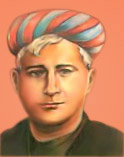Kapalkundala, set against the rural background of 19th century, mainly depicts the society infected with religious fanaticism and superstitions. The spontaneity and normal social set up of rural Bengal, blighted with tantricism is the fundamental theme of the novel. The exploitation of the ignorant people, who are either the strict followers of the accepted social norms or the clique of the putrefied religion, became the direct victim of the religious fanatics. The novel is an explicit disapproval against the priest craft, popularized as tantricism
 Author: - One of the famous stalwarts of Bengal renaissance, Bankim Chandra was born in a district of 24 parganas, on 27th June 1838 in an orthodox Brahmin family. Born in a family belongs to a higher social stratum, which is even orthodox, he never became the prey of religious fanaticism, but the miseries of the individuals in his surrounding, gradually became the quarry of priest craft and orthodoxy embarrassed him. Bankim Chandra, a social reformer in spirit also sympathized with the quiescent women folk of rural Bengal and his Kapalkundala is the mere representation of the social status of the women in the contemporary era.
Author: - One of the famous stalwarts of Bengal renaissance, Bankim Chandra was born in a district of 24 parganas, on 27th June 1838 in an orthodox Brahmin family. Born in a family belongs to a higher social stratum, which is even orthodox, he never became the prey of religious fanaticism, but the miseries of the individuals in his surrounding, gradually became the quarry of priest craft and orthodoxy embarrassed him. Bankim Chandra, a social reformer in spirit also sympathized with the quiescent women folk of rural Bengal and his Kapalkundala is the mere representation of the social status of the women in the contemporary era.
Synopsis: - The rural milieu of 19th century, ingrained with tantricism presents Kapalkundala as a romantic novel of Bankim Chandra Chattopadhya. The romantic amorous relationship between Nabakumar and Kapalkundala is the heart of the novel. The zamindar Nabakumar once being shipwrecked took refuge in a forest caped island, where he met Kapalkundala, lived in the shelter of a Tantric saint. The passionate urge between each other ultimately finds expression in the marriage of Nabakumar and Kapalkundala. Liberated from the shackles of the recluse, Kapalkundala, stated to survive in the normal world as Mrinmoyee, the wife of zamindar. But the Tantric rediscovered the true face of Mrinmoyee and bullied her to relinquish the family life. Finally to save her family and her beloved Nabakumar, she committed suicide, to desert her family as well as her own life.
Kapalkundala, centers round the life and activities of the protagonist Kapalkundala, later known as Mrinmoyee. The title truly signifies the sacrifice and penalty, she has to give being a poor prey of religious extremism. Through a bold presentation of the heroine Kapalkundala, Bankim Chandra represents the predicament of the entire womenfolk, who became the victim of the socio-religious conventions.
Kapalkundala, highly applauded in its time was a straight grievance to the social and religious orthodoxy. Its publication in 1866 stimulated the society. Acclaimed equally by both the readers and critics, Kapalkundala was also translated to English (more than once), Hindi, Gujarati, Tamil, Telegu and German languages.













